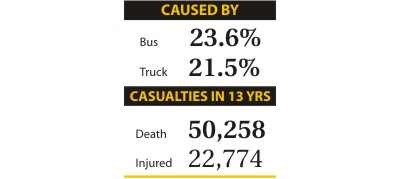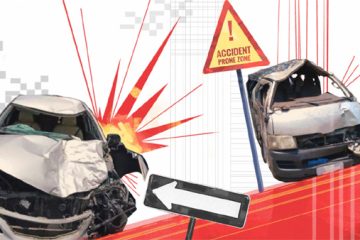States Buet’s 1998-2010 road accident research
Thirty percent of the road accidents from 1998 to 2010, which claimed around 1,200 lives every year, could have been averted if road dividers and speed bumps had been set up to check head-on and rear-end collisions.
During the period, 14,876 people were killed and 6,741 others injured in such collisions across the country, according to a report of Bangladesh University of Engineering and Technology (Buet).
Buet’s Accident Research Institute (ARI) analysed road accident data of 13 years (1998-2010) and found 45 percent of the accidents were caused by buses and trucks, most of which were illegally modified.
 Last year, 12,226 vehicles of five modes committed accidents, taking 2,467 lives. Of the vehicles, 1,063 were buses and 801 trucks, according to the ARI.
Last year, 12,226 vehicles of five modes committed accidents, taking 2,467 lives. Of the vehicles, 1,063 were buses and 801 trucks, according to the ARI.
Head-on and rear-end collisions constitute 29.6 percent of the total number of accidents, and they could have been avoided if the authorities concerned had installed adequate dividers and speed bumps on roads and highways, ARI experts say.
For example, the premature deaths of noted filmmaker Tareque Masud and media personality Ashfaque Munier Mishuk in Manikganj last year could have been avoided with road dividers and speed bumps in place.
In this particular incident, the microbus carrying them collided head-on with a bus on the Dhaka-Aricha highway at Ghior. The bus driver did not slow down even as he turned left, hitting the microbus after travelling about 10 yards from the turn, witnesses told reporters.
Speed bumps work as a deterrent on roads and highways to rear-end collisions, as drivers often with fake licences drive recklessly and run into other vehicles, said ARI Director Prof Hasif Mohammad Ahsan.
He added that all busy roads, irrespective of their size, should have dividers.
Illegal modification of buses and trucks is also to blame for frequent accidents.
“The bodies of almost cent percent buses and trucks are modified through ignoring rules, which is one of the main reasons for road crashes,” Prof Hasif told The Daily Star.
Usually, buses and trucks are modified in two ways — by increasing their length and width.
“It’s very difficult for a truck driver to notice vehicles coming from behind due to the illegally modified body, which is larger than the driver’s cabin,” he observed.
A truck’s width and its driver’s cabin must be of the same size, he insisted.
Contacted, Bangladesh Road Transport Authority Director (enforcement) Tapan Kumar Sarker admitted that most of the vehicles plying the roads were illegally restructured.
“The BRTA has recently asked all the deputy commissioners to seize all the vehicles that have been illegally modified. And we are also conducting mobile courts in this regard,” he said.
The ARI report prepared last month reveals yet another frustrating trend: that although the number of road accidents is rising every year, police reports have it otherwise.
ARI sources said they prepared the report based on police record, which showed 3,656 accidents in 2008, 2,802 in 2009 and 2,437 in 2010, indicating a downtrend.
Prof Hasif, however, differs with the police record. He says the ARI report does not reflect the reality due to “under-reporting” by the police.
The actual number of road accidents will be four to five times the police figure, he said, quoting various foreign organisations.
On the fitness of the vehicles, the BRTA director said all the five Vehicle Inspection Centres (two in Dhaka and one each in Rajshahi, Khulna and Chittagong) were inoperative for long, forcing them to inspect the vehicles manually.
The job of fitness inspection would be done through outsourcing in private workshops, and that the process for that was underway, he added.
-With The Daily Star inpu




















